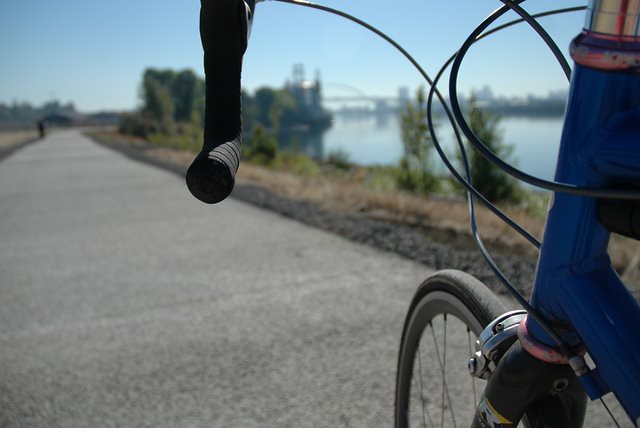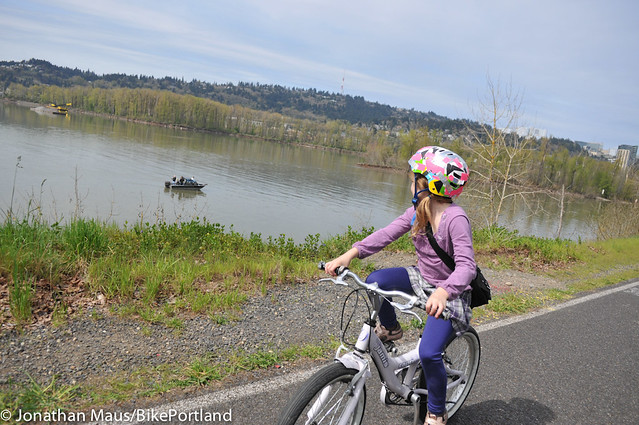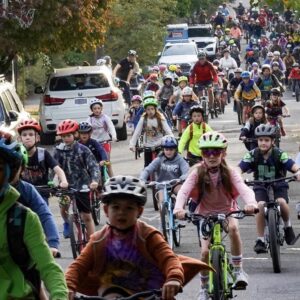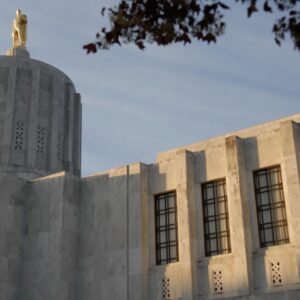
(Photos: J.Maus/BikePortland)
The Portland Bureau of Parks and Recreation is rarely discussed as part of the answer to Portland’s transportation problems.
Instead of relying mostly on relatively costly off-street paths, which are the main channels for low-stress bike transportation in most of the United States, Portland generally prides itself on improving its actual streets for biking.
But the city’s parks bureau is currently facing a problem that many transportation advocates don’t know about: How to spend the tens of millions of dollars in fees from new development that have been pouring into city coffers for years now.
To be clear, the parks bureau has a very long wish list, worth $1.2 billion over the next 20 years. More biking and walking paths are only part of it.
But a number of potentially major biking corridors — the Red Electric Trail and Willamette Greenway Trail in the southwest, Sullivan’s Gulch Trail in the northeast, the North Portland Greenway in the north — have been envisioned for years and are mostly just awaiting cash.
It’s cash that the parks bureau, increasingly, might be able to start spending.

System development charges, the fees paid to the city by developers of new buildings, will rise sharply on July 1. In March, a city budget report showed that SDCs have already been arriving at the city faster than it’s been spending them, piling up to a $42 million stash by last summer. During fiscal year than ends June 30, the city is expected to have collected $20 million more.
Compare those figures to the $1.4 million per year that the city’s new gas tax will dedicate to protected bike lanes and neighborhood greenways, and you begin to get a sense of how much difference a bit of parks funding could make for transportation.
Advertisement
Here’s a list of $55 million in possible work on the four trails mentioned above, all of it 100 percent eligible for system development charge money and 95 percent of it allocated to be spent in the early 2020s, if the city council ever decided to add it to the bureau’s to-do list.
New parks and trails would also increase the city’s operating expenses
Though a surplus of money for constructing and improving parkland is obviously a good problem for Portland to have, it does come with complications — for example, the need for the operating funds that keep new parkland clean and safe.
System development charges can’t be spent on mowing crews or park rangers, for example; property taxes and other revenue would be needed for that. This is from the city budget report:
The expansion of parks services will necessarily require a shift of General Fund resources away from other City priorities, such as public safety and housing, in order to fund the operations and maintenance of new park facilities. The City needs to take into account the negative impact of reducing these other services – along with the equity impact this may have on specific communities – when making decisions about expanding Parks’ services.
And this:
Council’s recent direction to no longer enforce camping restrictions on public spaces has caused an increase in the need for ranger services in parks across the city, but particularly along the Springwater Corridor Trail. Rangers receive some training in working with homeless individuals and referring them to appropriate service providers; however, CBO notes that to the degree other solutions in the FY 2016-17 budget alleviate the number of individuals camping in parks, the demand for this type of ranger service may be lessened. Second, due to staffing constraints in the Police Bureau, there has been a decrease in patrolling and community policing, which have increased reliance on Park Rangers to provide response to non-urgent park incidents. Whereas some safety concerns were previously being addressed by police officers, rangers now address these situations or the situations are not addressed.
All public space requires operating costs. For cities, the question is whether it can deliver value to justify those costs.
Most Portlanders like parks; a 2014 property tax ballot measure to repair old ones won by a 43 point margin. And most Portlanders like bicycling, too, both transportation and recreation. Combining two values together to find the common links, though, would require politics.
— Michael Andersen, (503) 333-7824 – michael@bikeportland.org
Our work is supported by subscribers. Please become one today.







How does taking this money from the parks department effect their operations going forward?
Income based on fees and taxes is not consistent. The parks department has to think about these things and budget these monies to handle the ups and downs. Note in the graph that in 2010, that surplus was almost nil.
Just because they have a surplus doesn’t mean it has to be spent right now. Every financial expert says, build an emergency fund, be prepared. I like that the parks department has a reserve.
SDC funds cannot be used for maintenance and operation, or emergency funds. They have to be used to increase the system capacity (more parks). More parks mean an increase in maintenance and operations.
Seems like something Portland residents would willingly bond.
Which is part of the problem. Build as much as you can with this money, and not have the income to properly maintain those parks. If you build it you have to keep it maintained, you can’t defer that or you get pot holes and unsafe bridges. Then it’s just another tax here another tax there. Fiscal responsibility is something Portland needs to work on.
Unless we are talking about singletrack trails, in which case we have a whole bunch of people waiting to do the maintenance for free!
You’ve provide no evidence of fiscal malfeasance, and BTW, taxes are how things are paid for that benefit society.
Really, deferring road maintenance for years to pay for light rail isn’t malfeasance? Yes taxes are how things are paid for, but that tax money needs to be treated as finite, not some bottomless well that can be dipped into over and over again.
Build it! More trails mean more people looking out for one another!
I love Portland’s on-street bike transportation system, but I also recognize that I am in the considerable minority of riders and potential riders. I have become relatively comfortable riding in bike lanes exposed to significant car traffic, but riding in close proximity to car traffic will remain a barrier for many. More off-street trails will make an enormous contribution to increasing cycling for both fun and transportation. We need to invest in this sort of infrastructure, as well as more on-street means of separating bikes from motorized traffic.
not to mention how many greenways might be shorter if they could easily go through a park, or two.
Narrow, bumpy trails with tight corners through a dark woods are not a safe transportation network. First build the connections everyone can use all the time. It’s fine to have them set slightly into the park on a stretch with no intersections, but we need lighting and none of this “closes at dusk”.
Agreed!! Ever ride the Springwater Trail after dark?
Closing at dusk is ridiculous, but we don’t always need lighting. If there must be lighting, make it more like Paris and less like a Walmart parking lot.
That is why abandoned, unused rail lines in Portland need to be used for trails and cycle tracks (NW Portland bike week coverage).
#$@%$!%! People are getting killed on the streets and we have all of this money for off-street facilities just sitting there?
The City Council adopted the Sullivan’s Gulch Trail Concept Plan in 2012:
https://www.portlandoregon.gov/parks/article/469560
and the North Portland Greenway Trail Alignment Plan in 2013:
https://www.portlandoregon.gov/parks/article/468306
In the three to four years since then painfully little progress has been made on either project. Both plans identified segments that could be built individually, without needing to build the whole alignment at once. When Parks literally has tens of millions of dollars it doesn’t know what to do with, it’s really frustrating that they haven’t been willing to commit to building at least the easiest sections identified in either plan.
How much does Union Pacific have to do with both of those delays though?
I honestly have no idea, but both trails have discrete sections that don’t require negotiations with Union Pacific.
Ah, discrete sections, my favorite aspect of a trail “network”.
The Eastbank Esplanade / Springwater Corridor wasn’t all built in one phase. Indeed, it’s not even finished. But that doesn’t meant that the sections that were built first lacked independent utility. Building, say, the section of the North Portland Greenway from Cathedral Park to Kelly Point Park would be useful to a great many people, even if it didn’t yet connect to Downtown Portland.
I would love to see Parks get going on the NP Greenway, but I would prefer to see PBOT do it! Parks did a horrible job on the 30% set- so many blunders, ignoring comments, lacking vision, no value placed on pleasant experience, etc. Similarly, when they built the Waud Bluff Trail, they used “letter of the law” reasoning to build stairs when a ramp would have served exponentially more people. PP&R is very short-sighted, not inclusive by nature and they do not understand cycling as transportation or recreation. While I am thrilled that they have money to spend, I remain suspicious to pull off Sullivan’s Gulch or NP Greenway without significant help from PBOT
Maybe they could use a little of the money to repave/repair the Willamette Greenway Trail — just as a stopgap. That route has become a bone-jarring, root-laden path in significant places. If you haven’t ridden it lately, it’s a mess.
Black cottonwood trees have roots that grow far.
While that definitely needs to happen, SDCs can’t legally be used for repair or maintenance.
expansion of the system, like widening trails, could probably be defended. And if you’re going to widen a trail, say from 10 or 12 feet, to 16 feet with delineation for cyclist separate from pedestrians, who is to say that the current facility should remain.
Replacement of an older design standard with a newer, increased capacity, design standard should qualify for SDC funding.
World class Springwater Trail, with enhanced road crossings and neighborhood connections, anyone?
The NWTA, DOD, WTF, HRats, and other mountain bike groups all maintain the trails that they are allowed to ride on. If anyone had the bravado to allow singletrack in Portland, it would be virtually free to upkeep. Singletrack belongs in town, and it could be part of a network for commuting. I know my optimum route home consists of dirt. The Parks Bureau needs a leader that can manage and lead, without injecting personal bias into programming and access decisions. This surplus is evidence of something that’s not right at the Parks Department.
Not if the nutty nimby’s don’t have anything to do with it..
Interesting since portland parks and rec just emailed a survey asking which programs to cut since it was facing a budget deficit. Cut programs for preschool, teenagers, adults or elderly? I guess this extra money can’t be used for existing programs.
Probably the S in SDC – System Development Charges, not Program Development Charges.
I have ridden in towns that have a great multi use path network. Riding on streets with cars is lame if you have kids or you are riding with someone who isn’t fearless. Drainage ways are great ways to alight multi use paths. Now..if only the fearless crew…don’t ruin it.
I regularly ride on the road, but it’s so NICE to get onto a separated MUP and be able to relax and enjoy the ride. My favorites are Banks-Vernonia, the Corvallis-Philomath path, and the Ten Mile Canyon trail from Breckenridge to Vail. And I probably wouldn’t be riding to work now if not for the Hwy 26 MUP.
Typical bike paths and MUP’s in Portland and surrounding communities, are expensive to build and maintain, because they’re graded for, and paved with asphalt to meet accessibility needs of people that can’t walk or ride a bike. Dirt paths probably can’t be designed, built and maintained to satisfactorily support the wide range of travel mode needs the public expects regional travel-recreational trails to provide.
The section of the Columbia Slough Trail that runs along the levee from Portland Rd. to the newly-completed underpass at N Denver (and the new section of the trail that goes to N Vancouver) is abysmal–the pavement has completely disappeared on parts of it and the rest is ancient, rutted, crumbling, barely 1-2 ft. wide pavement only fit for mountain bikes. Yet this is a vital missing link from N. Portland neighborhoods out to the nice trails through Smith/Bybee Lakes and out to Kelly Point. Does anyone know if this is even on PP&R’s radar? Any ideas how to get them to repave it?